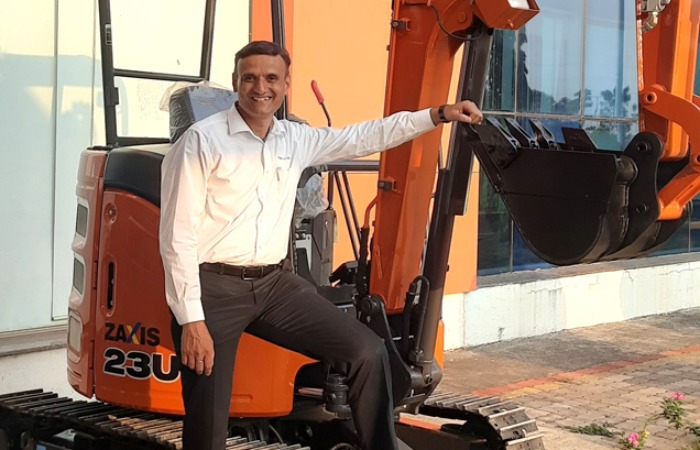
BS-V compliance has increased the cost of backhoe loaders
Siddharth Chaturvedi, Head Marketing, Tata Hitachi Construction Machinery, shares insights on the BS-V transition, backhoe loader demand outlook, and customer support strategies for FY2026.
After a subdued FY 2025 influenced by pre-buying trends, what are your expectations for the backhoe loader market in FY 2026? What will shape the demand landscape?
FY2026 is expected to witness a gradual recovery in backhoe loader sales. With the BS-V transition, the market should stabilise as customers adapt to the new standards. Growth is likely to be driven by continued infrastructure investments, rural development programmes, housing, and irrigation projects. Government-backed schemes and enhanced project execution at the state and central levels are also expected to create a steady demand environment.
What technological and safety upgrades have been implemented in backhoe loaders to meet the BS-V norms?
To comply with Bharat Stage-V (BS-V) emission norms and the latest safety regulations, backhoe loaders have undergone a series of significant upgrades aimed at enhancing environmental performance, operator safety, and overall machine reliability.
On the emissions front, the machines now incorporate advanced engine technologies, including electronically controlled common rail direct injection (CRDI) systems that enable precise fuel delivery for optimised combustion. In addition, after-treatment systems such as diesel oxidation catalyst (DOC), diesel particulate filter (DPF), and selective catalytic reduction (SCR) have been integrated to effectively reduce particulate matter and nitrogen oxide emissions. These enhancements not only meet the stringent BS-V standards but also contribute to improved fuel efficiency and lower operating costs over the long term.
From a safety and regulatory standpoint, significant improvements have been made in compliance with updated central motor vehicle rules (CMVR). Operator cabins are now equipped with Level 2 roll-over protective structure (ROPS) and falling object protective structure (FOPS), offering enhanced safety in challenging work environments. Modern braking systems have been introduced for improved control and reduced stopping distances, while redesigned cabins with expanded glass areas, rear view mirrors, and optional cameras enhance operator visibility. Additional features such as mandatory seat belts, ergonomic seating, appropriate lighting, signage, and audible alerts further support safe and efficient machine operation.
Together, these changes ensure that BS-V compliant backhoe loaders not only meet regulatory expectations but also deliver enhanced productivity, operator comfort, and on-site safety.
How has the shift to BS-V impacted machine pricing, and what support are you offering to ease this transition for customers?
BS-V compliance has increased the overall cost of backhoe loaders depending on the model. To help customers manage this, OEMs like Tata Hitachi are working on cost optimisation across the value chain. We are also offering value-added services, warranty coverage, and efficient after-sales support to ensure higher uptime and better returns on investment.
What strategies are in place to support budget-conscious buyers concerned about the costs of new fuel and electronic systems?
We understand the concerns of first-time and value-conscious buyers. At Tata Hitachi, we are focusing on simplifying technology while maintaining reliability and durability. We are strengthening our service network, ensuring ready availability of spares, and offering training to operators and mechanics. Our approach is to make the transition as seamless as possible with robust support and transparent communication.
What are the long-term advantages of BS-V compliant machines in terms of operational efficiency and profitability?
BS-V machines offer several long-term benefits—improved fuel efficiency, reduced emissions, enhanced machine diagnostics, and better overall performance. With electronic controls, proactive maintenance is possible, reducing unplanned downtimes. Over time, this translates into higher productivity, consistent availability, and ultimately better profitability for users.
Are there financing solutions available to help customers manage the higher upfront costs of BS-V machines?
Yes, we work with leading financial institutions and NBFCs to introduce tailored financing solutions. These include extended tenures, lower EMIs, leasing options, and seasonal repayment plans. Such initiatives are aimed at reducing the financial burden and enabling easier access to BS-V compliant equipment.
What should customers expect in terms of maintenance costs for BS-V machines compared to earlier models?
While BS-V machines come with additional emission-related components, they are designed for longer service intervals, improved diagnostics and optimised lifecycle cost. We are also offering maintenance packages and AMC plans to help customers manage costs effectively.
How are you equipping operators and mechanics to work with BS-V technology?
Absolutely. Training is a core part of our BS-V rollout strategy. We conduct operator and mechanic training programmes across our dealer network, at customer sites and we have designated operator training centres at both our manufacturing facilities in Dharwad, Karnataka and Kharagpur, West Bengal.


 +91-22-24193000
+91-22-24193000 Subscriber@ASAPPinfoGlobal.com
Subscriber@ASAPPinfoGlobal.com